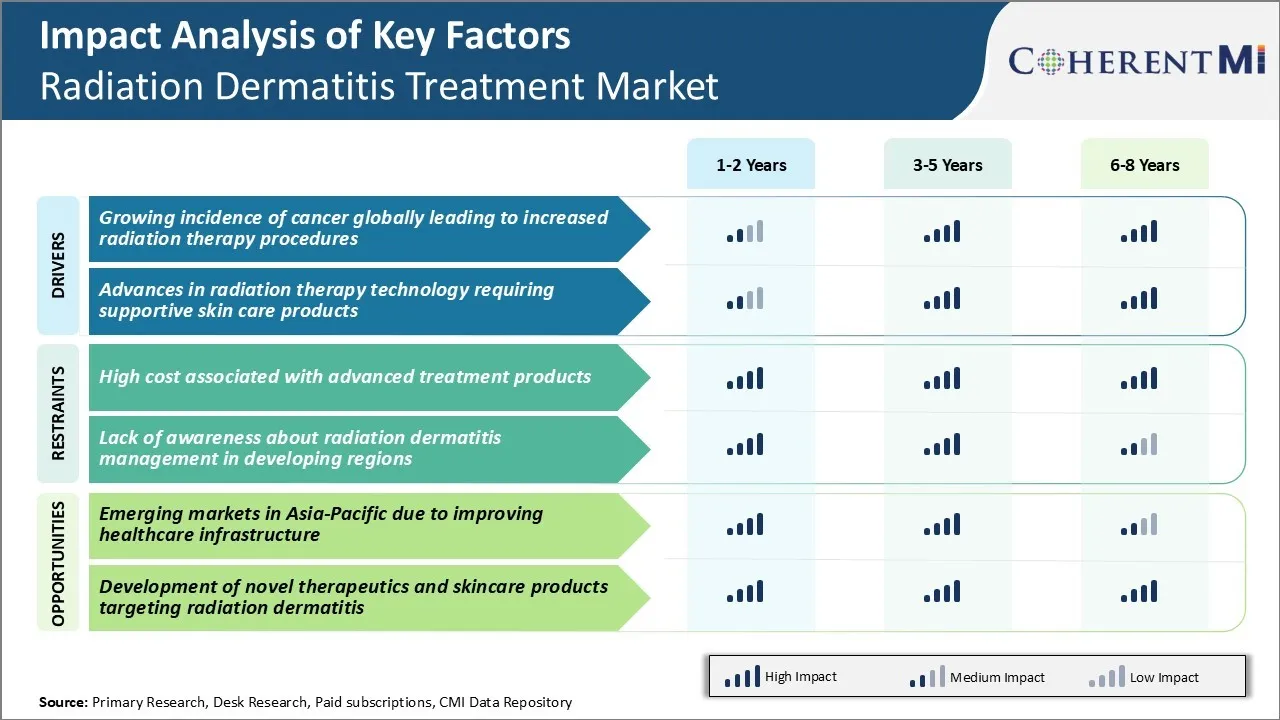Radiation Dermatitis Treatment Market Trends
Market Driver - Growing Incidence of Cancer Globally Leading to Increased Radiation Therapy Procedures
According to experts from WHO, cancer is one of the leading causes of death worldwide responsible for nearly 10 million deaths every year. As per estimates, around 50-60% of all cancer patients undergo some form of radiation therapy during their treatment journey either as a primary or adjuvant therapy.
Radiation therapy works by using high energy radiation like x-rays, gamma rays and other particles to damage the DNA of cancer cells. Though highly effective for cancer treatment, one of the major side effects of radiation therapy is radiation dermatitis.
With the growing patient pool undergoing radiation therapy worldwide, the incidence of radiation dermatitis has also increased considerably. As more people are diagnosed with cancer every year due to numerous causative factors and improving diagnostic methods, the number of those opting for radiation therapy either alone or in combination with other treatments is growing steadily.
The rising use of advanced radiation therapy techniques which involve delivering higher radiation doses to localized tumor regions has also contributed to higher risks of developing severe radiation dermatitis. Thus, healthcare professionals are prescribing supportive dermatitis care therapies to improve patient compliance to radiation schedules and reduce radiotherapy breaks.
Market Driver - Advances in Radiation Therapy Technology Requiring Supportive Skin Care Products
Radiation therapy has witnessed rapid technological advancement over the past few decades. While revolutionary for cancer treatment, these advanced technologies can potentially induce more acute and severe forms of radiation dermatitis due to factors like wider treatment fields, hypofractionated regimens and large cumulative radiation exposures.
Particularly, newer techniques involving flattening filter free (FFF) mode of linear accelerator deliver ultra-high radiation dose rates and allow completing treatments in shorter times. Though highly beneficial for reducing treatment durations, FFF radiation is associated with deeper radiation penetration and increased dermal reactions. Likewise, modern modalities such as brachytherapy utilizing implanted radioactive sources in close proximity to skin also predispose to severe dermatitis outcomes. With growing reliance on advanced technologies, the potential for debilitating radiation-induced skin injuries has also increased considerably.
To counter this, healthcare professionals are increasingly recognizing the importance of diligent skin care practices starting from the planning phases through the entire course of radiotherapy.
Proper education regarding skincare dos and don'ts is imparted to patients undergoing high-risk radiotherapy regimens. The need to supplement newer radiation modalities with responsible dermatitis mitigation measures is driving higher demand for specialized therapeutic skin products tailored for radiotherapy patients.

Market Challenge - High Cost Associated with Advanced Treatment Products
One of the major challenges faced by the radiation dermatitis treatment market is the high cost associated with advanced treatment products. Radiation therapy is an expensive process involving sophisticated equipment and qualified medical professionals. The treatment products used for radiation dermatitis such as hydrogel, hydrocolloid, alginate, no sting barrier film, and others often involve costly research and development. These advanced products not only provide effective moisture management and protection to the skin but also help in faster wound healing.
However, their high price tag makes them unaffordable for many patients undergoing cancer treatment. This acts as a barrier for wider acceptance and market growth of these products. Manufacturers need to focus on cost containment strategies through value engineering and competitive pricing to make these vital products more affordable and accessible to all sections of the patients’ population.
Market Opportunity: Emerging markets in Asia-Pacific due to improving healthcare infrastructure
One of the key opportunities for growth in the radiation dermatitis treatment market is the emerging economies in the Asia-Pacific region owing to improvements in healthcare infrastructure and rising medical tourism. Countries like India, China, Indonesia, Thailand and Vietnam have been witnessing substantial economic development over the past few decades. This has resulted in greater availability of advanced cancer treatment facilities and improved access to quality healthcare services for local populations.
At the same time, these nations have also emerged as popular medical tourism destinations for their quality services at affordable costs. As the availability and standard of radiation oncology services increase in the Asia-Pacific region, the incidence of radiation-induced dermatitis is also likely to grow. This presents lucrative business prospects for manufacturers of dermatitis treatment products to tap into these fast-growing markets through tailored pricing and distribution strategies.